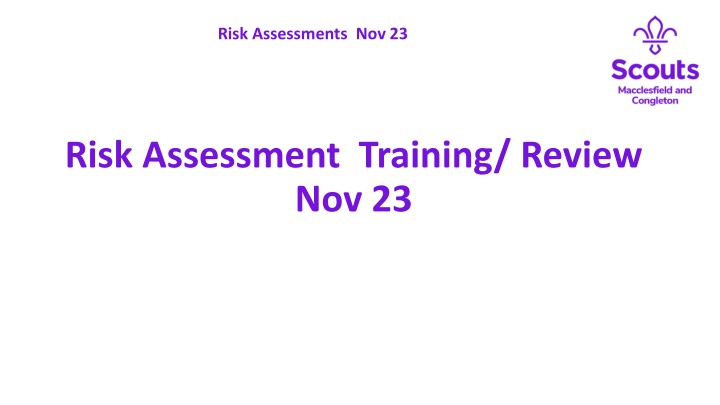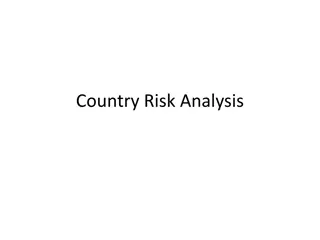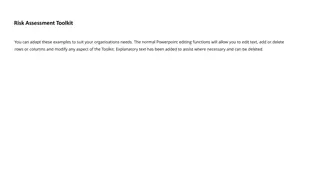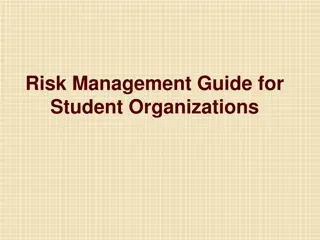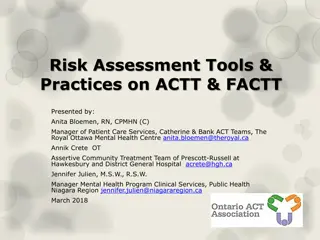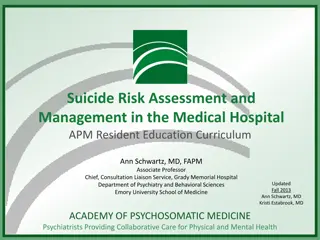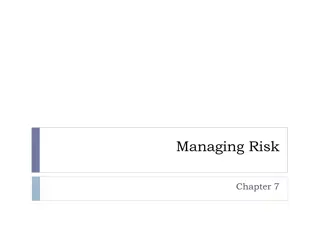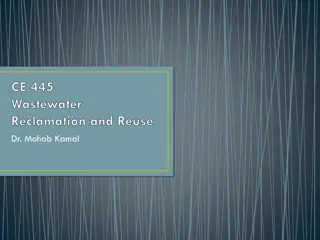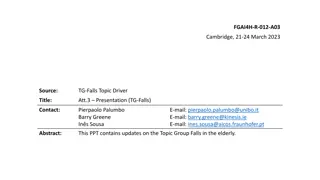Comprehensive Risk Assessment Training Overview
In this risk assessment training session held on November 23, participants reviewed the process of writing and reviewing risk assessments to enhance the quality of assessments for safer scouting experiences. The training aimed to improve leaders' skills and confidence in risk assessment practices while sharing best practices and highlighting available support across the district. The session covered the importance of producing risk assessments, preparing them in five simple steps, identifying hazards versus risks, and understanding the difference between them. Key takeaways include the necessity of risk assessments as per POR 9.1.1, balancing excitement with safety in scouting activities, and the continuous nature of risk assessment throughout an activity. Participants also learned about hazard identification and its importance in ensuring participant safety.
Download Presentation

Please find below an Image/Link to download the presentation.
The content on the website is provided AS IS for your information and personal use only. It may not be sold, licensed, or shared on other websites without obtaining consent from the author.If you encounter any issues during the download, it is possible that the publisher has removed the file from their server.
You are allowed to download the files provided on this website for personal or commercial use, subject to the condition that they are used lawfully. All files are the property of their respective owners.
The content on the website is provided AS IS for your information and personal use only. It may not be sold, licensed, or shared on other websites without obtaining consent from the author.
E N D
Presentation Transcript
Risk Assessments Nov 23 Risk Assessment Training/ Review Nov 23
Purpose of the training The desired outcomes from today are: Review the process of writing and reviewing Risk Assessments leading to:- Improved quality of RA s delivering safer scouting for all Improved skills and confidence in leaders in writing and reviewing RA s Share best practice and learning across the district Highlight areas of support available
Risk Assessments Nov 23 Why do we produce Risk Assessments?
Risk Assessments Nov 23 Why do we produce Risk Assessments? 1. It s a requirement in POR 9.1.1. 2. We want to provide EXCITEMENT but not DANGER; ADVENTURE but not HAZARD. Risk Assessment starts in the early stages of activity planning and goes on throughout the activity until all participants go home at the end of the activity. Covers the total time that YOU are responsible for the young people and adults in your party
Risk Assessments Nov 23 How do we prepare Risk Assessments?
Risk Assessments Nov 23 There are five simple steps. If you ve done risk assessments elsewhere, these should look familiar.
Risk Assessments Nov 23 Preparing RA s: overview of process
Risk Assessments Nov 23 1. Look for Hazards: Risks vs Hazards What is the difference between a Hazard and a Risk?
Risk Assessments Nov 23 1. Look for Hazards: : Risks vs Hazards A hazard is something with the potential to cause harm. The risk is the likelihood or probability of that harm occurring.
Risk Assessments Nov 23 1. Look for Hazards: : Hazard Identification Identify the Hazards in this Room
Risk Assessments Nov 23 1. Preparing RA s: Hazard Identification Hazards: objects or conditions that are present that can cause harm. Unsafe acts can be a hazard as well. Look for the hazards which are really obvious, not every single little thing. Item (e.g. a knife, saw) Substance (e.g. LPG, Food) Source of Energy (e.g. electricity or fire) Condition (e.g. Rough ground) Process (e.g. Cooking) Practice (e.g. Safeguarding) Behavior (e.g. Young people not understanding Safety Rules )
Risk Assessments Nov 23 2. Who might be harmed
Risk Assessments Nov 23 2. Who might be harmed and how We are on Kids+1 Camp. Who should be covered in our RA? What special considerations should we take into account?
Risk Assessments Nov 23 2. Who might be harmed and how Who is involved in the activity - young people, adult volunteers, parents, visitors, members of the public Different age groups will recognise risks differently as well as having a different attitude to risk requiring different levels of supervision Someone with a disability, visible or not, particularly important when doing an assessment, may have increased vulnerability to risk Hazards that you manage may be known and controlled as part of your regular meetings but visitors may not be aware of them familiarity is a risk
Risk Assessments Nov 23 3. How are Risks Controlled?
Risk Assessments Nov 23 3. How are Risks Controlled What are the methods of controlling risk?
Risk Assessments Nov 23 3. How are risks controlled? Controls are ways of removing or reducing risk. When deciding how risks are going to be controlled, it s useful to work through the following questions, in this order: 1. Can the hazard be removed entirely? 2. Is there a less risky option? 3. What can be done to reduce the risk of people being in contact with the hazard? 4. What instructions and supervision are needed? 5, Is protective or safety equipment available to reduce risk? Think about any special considerations or controls needed for those with additional needs (physical, mental, cultural etc.) Always start at the top of this list, if you can remove a hazard entirely that is always the best but if this is not possible then explore the other options in order.
Risk Assessments Nov 23 4. Record and Communicate your findings
Risk Assessments Nov 23 4. Record and Communicate your findings How do we record and communicate our findings?
Risk Assessments Nov 23 4. Record and Communicate your findings RAs must be recorded , usually on paper in a structured format Can be saved to a mobile device or notepad and audio recordings The key is that the method allows for it to be shared and communicated with others this includes fellow leaders, young people, parents, visitors etc. Dynamic RA s If plans change or there are additional hazards and risks not covered by the RA, or additional controls need to be put in place during an activity, RA s must be updated. If you need to do that on the spot it s called a dynamic risk assessment. Look to your existing risk assessment as your contingencies may be covered by this already. If not think through and discuss with others what's changed, going through the risk assessment steps and making sure you communicate the new plans clearly to those involved. Afterwards, consider if your documented risk assessment needs updating based on actions taken to manage the risk and update it if required
Risk Assessments Nov 23 4. Record and Communicate your findings Scout Association Template
Risk Assessments Nov 23 4. Record and Communicate your findings Communicating your findings: Examples Team Planning Meeting discuss at leader meetings. This will help you to put the assessment and controls together by asking those taking part. It also increases understanding and ownership. Team Briefing for all adults at the start of a camp or residential experience. Includes those who may not be regular members of the team and parents helping for the first time. Cover off the controls and reasons behind them. Camp Rules time planned in to explain rules (and reasons behind them) at the start of a camp to young people with leaders present. Ask young people what the hazards and risks are before they start the activity let them practice their skills and own part of the briefing use the what could go wrong? approach you can then fill in the bits they miss gets them to own the approach and empowers them to call out hazards you may not have identified Examples such as advising Scouts to be careful near the wood pile and reminding them to wear strong boots and gloves to avoid injury, explaining to them about the nails and splinters. Any control measure should be simple to communicate.
Risk Assessments Nov 23 5. Review and Revise plans where needed.
Risk Assessments Nov 23 5. Review and Revise plans where needed. Under what circumstances would you review and revise your RA s?
Risk Assessments Nov 23 5. Review and Revise plans where needed. 1. Risk assessments should be reviewed every 12 months as a minimum to see if anything has changed, and updated as needed, again making sure any changes are clearly explained to those involved. 2. As a result of a dynamic RA 3. If there s been a change of circumstances e.g. Time of year 4. If there s been a change of equipment e.g. Kayaks vs Canadian Canoes 5. If there s been a change of location e.g. Gradbatch vs Barnswood 6. if there s been an accident or near miss.
Risk Assessments Nov 23 5. Review and Revise plans where needed. What is the difference between an Accident and a Near Miss?
Risk Assessments Nov 23 5. Review and Revise plans where needed. Accident An unplanned event which causes injury to persons, damage to property or a combination of both. Near Miss An unplanned incident which does not cause injury or damage, but has the potential to do so.
Risk Assessments Nov 23 5. Review and Revise plans where needed. Why is it important to investigate Accidents and Near Misses?
Risk Assessments Nov 23 5. Review and Revise plans where needed
Risk Assessments Nov 23 5. Review and Revise plans where needed. Accidents As well as reporting and recording any accidents, it is important to get to the root cause or causes of the accident. A root cause can be defined as: the highest-level cause that sets in motion the entire cause-and-effect reaction that ultimately leads to the problem(s) This may not be obvious, and it may be necessary to carry out an accident investigation to determine the root cause or causes of the accident. If the root cause is not identified, corrective actions may only deal with symptoms not root causes. If groups require support in this area, there are District Team members who can help with this. Please do not hesitate to ask for help.
Risk Assessments Nov 23 5. Review and Revise plans where needed. Near Misses Reporting Reporting near misses allows us to identify patterns of incidents and update best practice advice and guidance for Members to support future activities. This is particularly important when it relates to issues with specific equipment or procedures that may have a wider impact. The reporting and investigation of near misses and accidents is not to place any blame on those involved, but an important part of safeguarding others from harm in similar incidents in the future.
Risk Assessments Nov 23 Recap
Risk Assessments Nov 23 Where can you get further help and advice?
Risk Assessments Nov 23 Where can you get further help and advice? Scout Website https://www.scouts.org.uk/volunteers/staying-safe-and-safeguarding/risk-assessments/
Risk Assessments Nov 23 Where can you get further help and advice? Scout Website https://www.scouts.org.uk/volunteers/staying-safe-and-safeguarding/risk-assessments/example-risk-assessments/
Risk Assessments Nov 23 Where can you get further help and advice? Other leaders Young people District team Nights Away Ian Mackintosh A.A Steve Richmond Activities Ian Mackintosh/Neil Raval/Mike Brown SHE Compliance Ian Mackintosh
Risk Assessments Nov 23 What questions do you have now?
